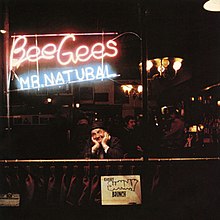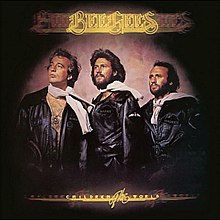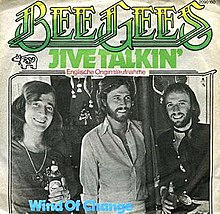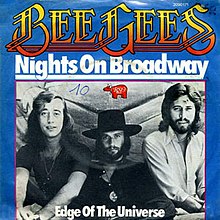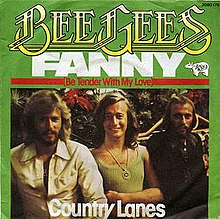
Rock and roll music
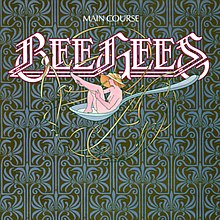
1975 studio album by the Bee Gees
Main Course is the thirteenth studio album (eleventh worldwide) by the Bee Gees, released in 1975 by RSO Records. It was the group`s last album to be released by Atlantic Records in the US under its distribution deal with Robert Stigwood. This album marked a great change for the Bee Gees as it was their first album to include mostly R&B, soul and funk-influenced songs, and created the model for their output through the rest of the 1970s. It rejuvenated the group`s career and public image, particularly in the US, after the commercial disappointment of their preceding albums. Main Course was the first album to feature keyboardist Blue Weaver who had just left the Strawbs and toured with Mott the Hoople. The album cover with the band`s new logo designed by US artist Drew Struzan made its first appearance here.
Leer másMain Course
The Bee Gees
Label: RSO · Studios: Criteria (Miami); Atlantic (New York) · Productor: Arif Mardin
CHARTS
AUS
CAN
GER
NZ
US
CERTIFICATIONS
US: Gold
|
1
|
Nights On Broadway
The Bee Gees •
The Bee Gees •
w: Barry, Robin and Maurice Gibb •
v: Barry and Robin •
1975 /06
|
4:34 |
|
|
|
2
|
Jive Talkin'
The Bee Gees •
The Bee Gees •
w: Barry, Robin and Maurice Gibb •
v: Barry •
1975 /06
|
3:45 |
|
|
|
3
|
Wind Of Change
The Bee Gees •
Bee Gees, The •
w: Barry and Robin Gibb •
v: Barry and Robin •
1975 /06
|
4:55 |
|
|
|
4
|
Songbird
The Bee Gees •
Bee Gees, The •
w: Maurice Gibb, Blue Weaver •
v: Barry •
1975 /06
|
3:39 |
|
|
|
5
|
Fanny (Be Tender With My Love)
The Bee Gees •
The Bee Gees •
w: Be Tender with My Love •
v: Barry and Robin •
1975 /06
|
4:07 |
|
|
|
6
|
All This Making Love
The Bee Gees •
Bee Gees, The •
w: Barry and Robin Gibb •
v: Barry and Robin •
1975 /06
|
3:07 |
|
|
|
7
|
Country Lanes
The Bee Gees •
Bee Gees, The •
w: Barry and Robin Gibb •
v: Robin (with Barry) •
1975 /06
|
3:30 |
|
|
|
8
|
Come On Over
The Bee Gees •
Bee Gees, The •
w: Barry and Robin Gibb •
v: Robin and Barry •
1975 /06
|
3:29 |
|
|
|
9
|
Edge Of The Universe
The Bee Gees •
Bee Gees, The •
w: Barry and Robin Gibb •
v: Barry and Robin •
1975 /06
|
5:25 |
|
|
|
10
|
Baby As You Turn Away
The Bee Gees •
Bee Gees, The •
w: Maurice Gibb •
v: Barry •
1975 /06
|
4:24 |
|
Singles
Jive Talkin
Fecha Lanzamiento: May 1975 · Fecha Grabación: 19 February 1975 -Discográfica: RSO · Estudio de Grabación: Criteria, Miami · Productor: Arif Mardin
CHARTS
|
1
|
Jive Talkin
The Bee Gees •
The Bee Gees •
w: Barry, Robin and Maurice Gibb •
v: Barry •
1975 /05
|
3:47 |
|
|
|
2
|
Wind of Change
The Bee Gees •
Bee Gees, The •
w: Barry and Robin Gibb •
v: Barry and Robin •
1975 /05
|
4:55 |
|
Nights on Broadway
Fecha Lanzamiento: September 1975 · Fecha Grabación: 1975 -Discográfica: RSO · Estudio de Grabación: Criteria (Miami) · Productor: Arif Mardin
CHARTS
AUS
BEL
CAN
GER
NED
UK
US
ALBUM
CERTIFICATIONS
|
1
|
Nights on Broadway
The Bee Gees •
The Bee Gees •
w: Barry, Robin and Maurice Gibb •
v: Barry and Robin •
1975 /09
|
4:36 |
|
|
|
2
|
Edge of the Universe
The Bee Gees •
Bee Gees, The •
w: Barry and Robin Gibb •
v: Barry and Robin •
1975 /09
|
5:25 |
|
Fanny (Be Tender with My Love)
Fecha Lanzamiento: January 1976 · Fecha Grabación: 1976 -Discográfica: RSO · Estudio de Grabación: Criteria (Miami) · Productor: Arif Mardin
CHARTS
AUS
BEL
CAN
GER
US
ALBUM
|
1
|
Fanny (Be Tender with My Love)
The Bee Gees •
The Bee Gees •
w: Be Tender with My Love •
v: Barry and Robin •
1976 /01
|
4:05 |
|
|
|
2
|
Country Lanes
The Bee Gees •
Bee Gees, The •
w: Barry and Robin Gibb •
v: Robin (with Barry) •
1976 /01
|
3:30 |
|
| Main Course | ||||
|---|---|---|---|---|
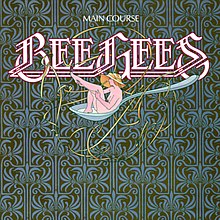 | ||||
| Studio album by the Bee Gees | ||||
| Released | June 1975 (US) August 1975 (UK) | |||
| Recorded | 6 January – 21 February 1975 | |||
| Studio | ||||
| Genre | ||||
| Length | 40:56 | |||
| Label | RSO | |||
| Producer | Arif Mardin | |||
| The Bee Gees chronology | ||||
| ||||
| Singles from Main Course | ||||
| ||||
Review
1975 studio album by the Bee Gees
Main Course is the thirteenth studio album (eleventh worldwide) by the Bee Gees, released in 1975 by RSO Records. It was the group`s last album to be released by Atlantic Records in the US under its distribution deal with Robert Stigwood. This album marked a great change for the Bee Gees as it was their first album to include mostly R&B, soul and funk-influenced songs, and created the model for their output through the rest of the 1970s. It rejuvenated the group`s career and public image, particularly in the US, after the commercial disappointment of their preceding albums. Main Course was the first album to feature keyboardist Blue Weaver who had just left the Strawbs and toured with Mott the Hoople. The album cover with the band`s new logo designed by US artist Drew Struzan made its first appearance here.
Leer másBackground
Working with Atlantic producer Arif Mardin, who had also produced their previous album, Mr. Natural, and engineer Karl Richardson at Criteria Studios in Miami, their music became much more influenced by Funk sound over a base of R&B style being produced in Miami at the time. Main Course also featured the first prominent use of Barry Gibb`s falsetto. From Mr. Natural, the brothers retained new drummer Dennis Bryon and longtime lead guitarist Alan Kendall but added a new keyboard player, Bryon`s former Amen Corner colleague Blue Weaver, who would become one of only a small handful of non-Gibb musicians to receive composition credits on Bee Gees songs. At the suggestion of Eric Clapton, the Bee Gees moved to Criteria Studios in Miami, to start recording their next album. Barry recalled Clapton`s suggestion when he was trying to make a comeback: "Eric said, `I`ve just made an album called 461 Ocean Boulevard in Miami. Why don`t you guys go to America and do the same and maybe the change of environment will do something for you?` I think it was really good advice."[1]
Maurice Gibb, on the other hand, cites their manager Robert Stigwood as the first to suggest Miami as the best place to record new songs. "He [Robert] showed us the picture on the cover [of 461 Ocean Boulevard] and said, `You can rent that place and live there and record and get a sun tan.` We decided that it was our big chance to get serious about our music again so we went out there and did Main Course."[1]
Recording
According to producer Arif Mardin, when the Bee Gees arrived in Florida to record new material, he discovered that at the time, they were listening to a lot of American R&B groups` songs; as Mardin was known as an R&B producer, he suggested that they also listen to several high-charting R&B artists such as Stevie Wonder for an idea as to the kind of music he felt they should be making.[1]
The band`s sound became more technologically current with Mardin`s incorporation of modern synthesizers and dual bass lines (the synthesizer bass was played by Blue Weaver and bass guitar by Maurice Gibb) on many of the songs, which started when Weaver decided to overdub a synthesizer bass line on the original demo of "Jive Talkin`." Weaver later commented that "nothing new has been invented to make such a tremendous difference to the sound as the synthesizer did, compared to an orchestra."[1]
At first, the brothers were still writing in their old ways, with many of the songs being slower rock ballads. The first song recorded for the album was an unreleased track "Was It All in Vain?". The next songs recorded were "Country Lanes" and "Wind of Change". After co-producer Robert Stigwood heard these songs, he urged them to record in a more R&B style and "Wind of Change" was re-recorded again in February in its more familiar version. Another unreleased track, "Your Love Will Save the World" was recorded on 9 January, though it was later recorded by Percy Sledge. Once the Gibb brothers changed their style of writing, songs like "Jive Talkin`", "Nights on Broadway" and "Edge of the Universe" were recorded with an R&B influence, though ballads like "Songbird" and "Come on Over" were more country than R&B. The final song recorded for the album was "Baby As You Turn Away" which featured Barry singing the verses in falsetto, though not the strong falsetto which he would develop and use on future songs like "You Should Be Dancing" and "Stayin` Alive".[2]
Release
| Review scores | |
|---|---|
| Source | Rating |
| AllMusic | [3] |
| Christgau`s Record Guide | B+[4] |
| Encyclopedia of Popular Music | [5] |
| The Great Rock Discography | 7/10[6] |
| Rolling Stone | (ambivalent)[7] |
| The Rolling Stone Album Guide | [8] |
The album peaked at No. 14 on the US Billboard album chart in 1975 and remained on Billboard`s Top 200 albums chart for 74 weeks until December 1976 on the strength of its three singles that charted on Billboard`s single chart: "Fanny (Be Tender with My Love)" at No. 12, "Nights on Broadway" at No. 7, and "Jive Talkin`" at No. 1. A live version of a fourth song, "Edge of the Universe" from the album Here at Last... Bee Gees... Live, reached No. 26. "Come on Over" later became a moderate hit (#23) in a cover version by country/pop artist Olivia Newton-John. The album also peaked No. 1 at the Canada`s RPM Albums Chart.
Track listing
| No. | Title | Writer(s) | Lead vocal(s) | Length |
|---|---|---|---|---|
| 1. | "Nights on Broadway" | Barry Gibb, Robin Gibb, Maurice Gibb | Barry and Robin | 4:36 |
| 2. | "Jive Talkin`" | Barry Gibb, Robin Gibb, Maurice Gibb | Barry | 3:47 |
| 3. | "Wind of Change" | Barry Gibb, Robin Gibb | Barry and Robin | 5:01 |
| 4. | "Songbird" | Barry Gibb, Robin Gibb, Maurice Gibb, Blue Weaver | Barry | 3:35 |
| 5. | "Fanny (Be Tender with My Love)" | Barry Gibb, Robin Gibb, Maurice Gibb | Barry and Robin | 4:06 |
| No. | Title | Writer(s) | Lead vocal(s) | Length |
|---|---|---|---|---|
| 1. | "All This Making Love" | Barry Gibb, Robin Gibb | Barry and Robin | 3:03 |
| 2. | "Country Lanes" | Barry Gibb, Robin Gibb | Robin (with Barry) | 3:31 |
| 3. | "Come On Over" | Barry Gibb, Robin Gibb | Robin and Barry | 3:27 |
| 4. | "Edge of the Universe" | Barry Gibb, Robin Gibb | Barry and Robin | 5:25 |
| 5. | "Baby As You Turn Away" | Barry Gibb, Robin Gibb, Maurice Gibb | Barry | 4:29 |
Personnel
Bee Gees
- Barry Gibb – lead, harmony, and backing vocals; rhythm guitar
- Robin Gibb – lead, harmony, and backing vocals
- Maurice Gibb – harmony and backing vocals, bass guitar, lead and rhythm guitars
Bee Gees band
- Blue Weaver – keyboards, synthesizers, synth bass
- Alan Kendall – lead guitar, steel guitar
- Dennis Bryon – drums, percussion
Additional musicians and production
- Joe Farrell – tenor saxophone on "Winds of Change"
- Don Brooks – harmonica on "Winds of Change"
- Ray Barretto – congas on "Songbird"
- Strings conducted by Gene Orloff
- Produced and arranged by Arif Mardin
- Engineered by Karl Richardson and Lew Hahn
Charts
Weekly charts
| Year-end charts
|
Certifications and sales
| Region | Certification | Certified units/sales |
|---|---|---|
| Canada (Music Canada)[18] | 2× Platinum | 200,000^ |
| United States (RIAA)[19] | Gold | 500,000^ |
^ Shipments figures based on certification alone. | ||
1975 studio album by the Bee Gees
Main Course is the thirteenth studio album (eleventh worldwide) by the Bee Gees, released in 1975 by RSO Records. It was the group`s last album to be released by Atlantic Records in the US under its distribution deal with Robert Stigwood. This album marked a great change for the Bee Gees as it was their first album to include mostly R&B, soul and funk-influenced songs, and created the model for their output through the rest of the 1970s. It rejuvenated the group`s career and public image, particularly in the US, after the commercial disappointment of their preceding albums. Main Course was the first album to feature keyboardist Blue Weaver who had just left the Strawbs and toured with Mott the Hoople. The album cover with the band`s new logo designed by US artist Drew Struzan made its first appearance here.
Background
Working with Atlantic producer Arif Mardin, who had also produced their previous album, Mr. Natural, and engineer Karl Richardson at Criteria Studios in Miami, their music became much more influenced by Funk sound over a base of R&B style being produced in Miami at the time. Main Course also featured the first prominent use of Barry Gibb`s falsetto. From Mr. Natural, the brothers retained new drummer Dennis Bryon and longtime lead guitarist Alan Kendall but added a new keyboard player, Bryon`s former Amen Corner colleague Blue Weaver, who would become one of only a small handful of non-Gibb musicians to receive composition credits on Bee Gees songs. At the suggestion of Eric Clapton, the Bee Gees moved to Criteria Studios in Miami, to start recording their next album. Barry recalled Clapton`s suggestion when he was trying to make a comeback: "Eric said, `I`ve just made an album called 461 Ocean Boulevard in Miami. Why don`t you guys go to America and do the same and maybe the change of environment will do something for you?` I think it was really good advice."[1]
Maurice Gibb, on the other hand, cites their manager Robert Stigwood as the first to suggest Miami as the best place to record new songs. "He [Robert] showed us the picture on the cover [of 461 Ocean Boulevard] and said, `You can rent that place and live there and record and get a sun tan.` We decided that it was our big chance to get serious about our music again so we went out there and did Main Course."[1]
Recording
According to producer Arif Mardin, when the Bee Gees arrived in Florida to record new material, he discovered that at the time, they were listening to a lot of American R&B groups` songs; as Mardin was known as an R&B producer, he suggested that they also listen to several high-charting R&B artists such as Stevie Wonder for an idea as to the kind of music he felt they should be making.[1]
The band`s sound became more technologically current with Mardin`s incorporation of modern synthesizers and dual bass lines (the synthesizer bass was played by Blue Weaver and bass guitar by Maurice Gibb) on many of the songs, which started when Weaver decided to overdub a synthesizer bass line on the original demo of "Jive Talkin`." Weaver later commented that "nothing new has been invented to make such a tremendous difference to the sound as the synthesizer did, compared to an orchestra."[1]
At first, the brothers were still writing in their old ways, with many of the songs being slower rock ballads. The first song recorded for the album was an unreleased track "Was It All in Vain?". The next songs recorded were "Country Lanes" and "Wind of Change". After co-producer Robert Stigwood heard these songs, he urged them to record in a more R&B style and "Wind of Change" was re-recorded again in February in its more familiar version. Another unreleased track, "Your Love Will Save the World" was recorded on 9 January, though it was later recorded by Percy Sledge. Once the Gibb brothers changed their style of writing, songs like "Jive Talkin`", "Nights on Broadway" and "Edge of the Universe" were recorded with an R&B influence, though ballads like "Songbird" and "Come on Over" were more country than R&B. The final song recorded for the album was "Baby As You Turn Away" which featured Barry singing the verses in falsetto, though not the strong falsetto which he would develop and use on future songs like "You Should Be Dancing" and "Stayin` Alive".[2]
Release
| Review scores | |
|---|---|
| Source | Rating |
| AllMusic | [3] |
| Christgau`s Record Guide | B+[4] |
| Encyclopedia of Popular Music | [5] |
| The Great Rock Discography | 7/10[6] |
| Rolling Stone | (ambivalent)[7] |
| The Rolling Stone Album Guide | [8] |
The album peaked at No. 14 on the US Billboard album chart in 1975 and remained on Billboard`s Top 200 albums chart for 74 weeks until December 1976 on the strength of its three singles that charted on Billboard`s single chart: "Fanny (Be Tender with My Love)" at No. 12, "Nights on Broadway" at No. 7, and "Jive Talkin`" at No. 1. A live version of a fourth song, "Edge of the Universe" from the album Here at Last... Bee Gees... Live, reached No. 26. "Come on Over" later became a moderate hit (#23) in a cover version by country/pop artist Olivia Newton-John. The album also peaked No. 1 at the Canada`s RPM Albums Chart.
Track listing
| No. | Title | Writer(s) | Lead vocal(s) | Length |
|---|---|---|---|---|
| 1. | "Nights on Broadway" | Barry Gibb, Robin Gibb, Maurice Gibb | Barry and Robin | 4:36 |
| 2. | "Jive Talkin`" | Barry Gibb, Robin Gibb, Maurice Gibb | Barry | 3:47 |
| 3. | "Wind of Change" | Barry Gibb, Robin Gibb | Barry and Robin | 5:01 |
| 4. | "Songbird" | Barry Gibb, Robin Gibb, Maurice Gibb, Blue Weaver | Barry | 3:35 |
| 5. | "Fanny (Be Tender with My Love)" | Barry Gibb, Robin Gibb, Maurice Gibb | Barry and Robin | 4:06 |
| No. | Title | Writer(s) | Lead vocal(s) | Length |
|---|---|---|---|---|
| 1. | "All This Making Love" | Barry Gibb, Robin Gibb | Barry and Robin | 3:03 |
| 2. | "Country Lanes" | Barry Gibb, Robin Gibb | Robin (with Barry) | 3:31 |
| 3. | "Come On Over" | Barry Gibb, Robin Gibb | Robin and Barry | 3:27 |
| 4. | "Edge of the Universe" | Barry Gibb, Robin Gibb | Barry and Robin | 5:25 |
| 5. | "Baby As You Turn Away" | Barry Gibb, Robin Gibb, Maurice Gibb | Barry | 4:29 |
Personnel
Bee Gees
- Barry Gibb – lead, harmony, and backing vocals; rhythm guitar
- Robin Gibb – lead, harmony, and backing vocals
- Maurice Gibb – harmony and backing vocals, bass guitar, lead and rhythm guitars
Bee Gees band
- Blue Weaver – keyboards, synthesizers, synth bass
- Alan Kendall – lead guitar, steel guitar
- Dennis Bryon – drums, percussion
Additional musicians and production
- Joe Farrell – tenor saxophone on "Winds of Change"
- Don Brooks – harmonica on "Winds of Change"
- Ray Barretto – congas on "Songbird"
- Strings conducted by Gene Orloff
- Produced and arranged by Arif Mardin
- Engineered by Karl Richardson and Lew Hahn
Charts
Weekly charts
| Year-end charts
|
Certifications and sales
| Region | Certification | Certified units/sales |
|---|---|---|
| Canada (Music Canada)[18] | 2× Platinum | 200,000^ |
| United States (RIAA)[19] | Gold | 500,000^ |
^ Shipments figures based on certification alone. | ||
More Albums same artist
VIDEOS
See Video Album Main CourseNights On Broadway · Channel: Bee Gees - Topic · 4m 34s


Bee Gees - Jive Talkin' · Channel: BeeGeesVEVO · 2m 51s

Wind Of Change · Channel: Bee Gees - Topic · 4m 56s

Songbird · Channel: Bee Gees - Topic · 3m 35s

NEW * Fanny (Be Tender With My Love) - Bee Gees {Stereo} · Channel: Smurfstools Oldies Music Time Machine · 4m 13s

All This Making Love · Channel: Bee Gees - Topic · 3m 3s

Country Lanes · Channel: Bee Gees - Topic · 3m 27s

Come On Over · Channel: Bee Gees - Topic · 3m 28s

Edge Of The Universe · Channel: Bee Gees - Topic · 5m 23s




